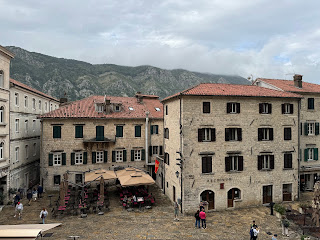Although there’s evidence of ancient settlements, Kotor was first recorded as the Roman town of Acruvium. It was later fortified by the Byzantines, was fought over by the Bulgarians and Serbs, Hungarians and Bosnians. In 1391 it achieved independence, only to accept the suzerainty of Venice as protection against the advancing Ottomans. So much history in such a small space. So many mountains, and like Dubrovnik, so many walls. Kotor now is a perfect example of a late medieval town.
A map of Kotor, small and contained within walls
If you study the photograph, you can see the walls of Kotor snaking up the mountain side. You will also see a small church. A woman we were talking to told us, that as a child, she was carried there on her grandmother’s back every Sunday.
As you walk through its winding lanes leading to unexpected squares and more churches than you can shake a stick at—if you’re that way inclined—you notice the cats. They’re everywhere. The Egyptians may have worshipped them, Kotor on the other hand feeds and protects them. Once, no doubt great ‘ratters’ they’ve become quite indolent and betray the quiet arrogance peculiar to cats.
It put me in mind of Algernon Blackwood’s wonderful short story Ancient Sorceries. In it, an English traveller steps from a train into another world, a medieval French village demonically possessed by cat spirits. At night, its otherwise attractive inhabitants turn into cat people. The book, in turn, was turned into the 1942 film Cat People. It could have been filmed here.
A statue of a stretching cat. There is, apparently, a Cat Museum.
Numerous sleeping cats
The Cathedral of St Tryphon, a third century martyr and a cult figure in Kotor. It was built in the C12th and took the form of a three nave basilica with a dome and three semi circular apses, a feature of Byzantine and Romanic architecture. An earthquake nearly destroyed it in the late C17th and the tower was rebuilt along Baroque lines.
A view of the square from the Cathedral balcony.
Church of St Luke, built in 1195 and surviving every earthquake. Over the centuries, orthodox and catholic have shared the church, their altars sometimes side by side. Unfortunately, we weren't allowed in,
The Orthodox cathedral of St Nicholas
Like Blackwood’s village, the people were both graceful and friendly, but I detected a number of feline traits. Exhausted and thirsty after so many churches, we wandered past one of the many cafes, where a waiter ushered us to a table and then promptly ignored us. We sat for ages until thirst prompted us to move. The same thing almost happened in the next open-air café. This time, the thirst for beer was overwhelming, and after ten minutes, I walked inside the bar where an elderly woman regarded me politely but puzzled. The next moment, I was aware of a presence. A young, piratical waiter had sidled up to me. He was close, shoulder and hip touching close. I turned, startled, and he gave me a piratical wink, which startled me even more. Orders taken I sat down and the beer arrived and for a moment I was in heaven.
The harbour wall that will snake up and around Kotor.
The wall passes behind the Orthodox Cathedral
Another cat, who may have been the waiter who ambushed me.
A similar thing occurred a little later on when we were walking the walls. We passed another open-air café and for a split second I thought I was being mugged. It was another waiter, one who appeared from behind and placed a friendly arm over my shoulder. I’d sprayed myself with Lynx that morning. Not catnip. It was all most puzzling.
I like Fred Olsen. Their ships look like ships, not floating tenements. They slide smoothly into the smaller harbours. But just then, I was thinking of dinner.
And we’re away! the Fjords of Scandinavia which were caused by ice gouging out gorges for water to fill, the fjords here were caused by earth movement and landslips on a massive scale, which water subsequently filled. The 3D map at the very top gives you an idea of the scale of the landslips and how nicely Kotor is situated in terms of defence. The photos below are of the maze of water leading from it to the open sea.








































































